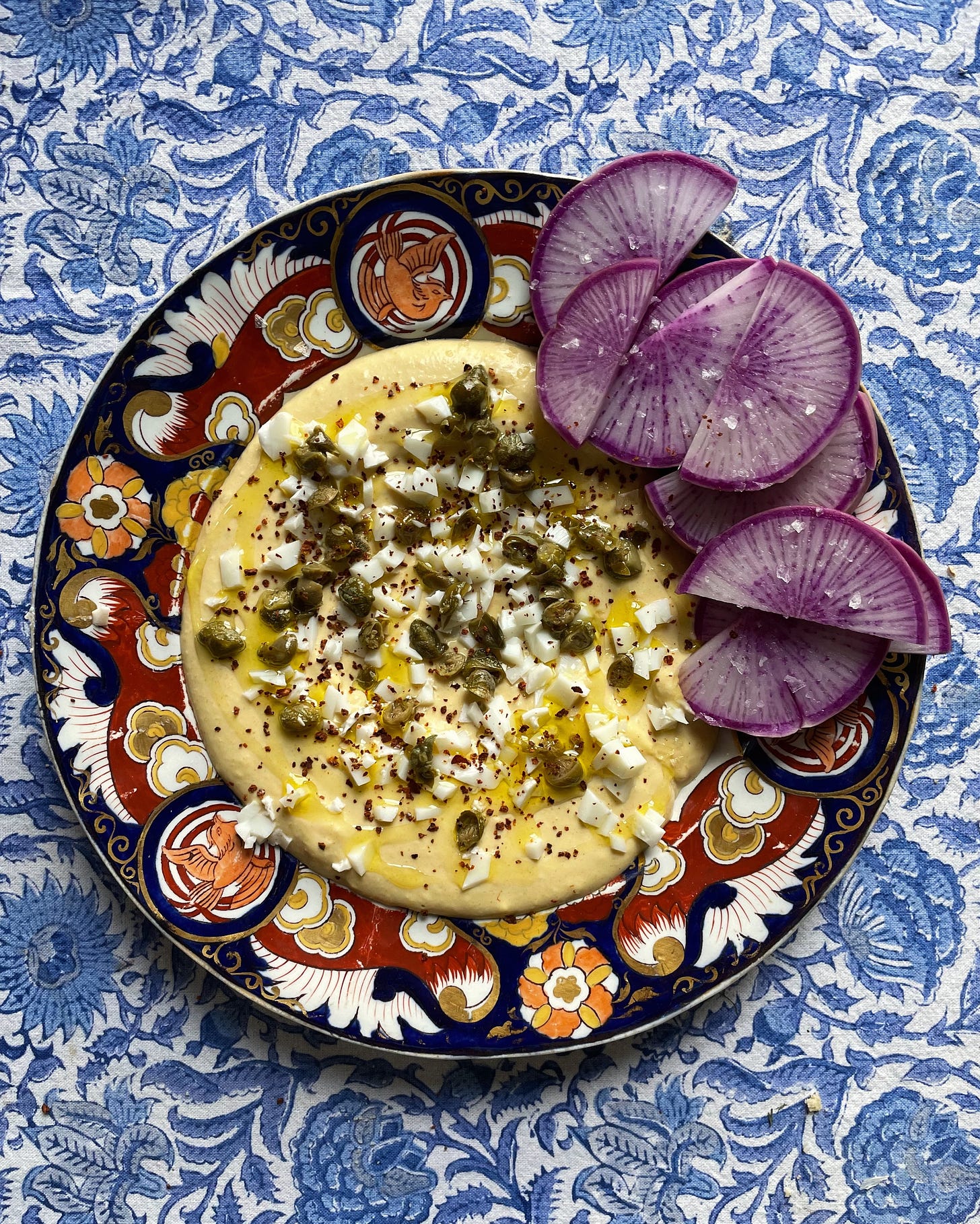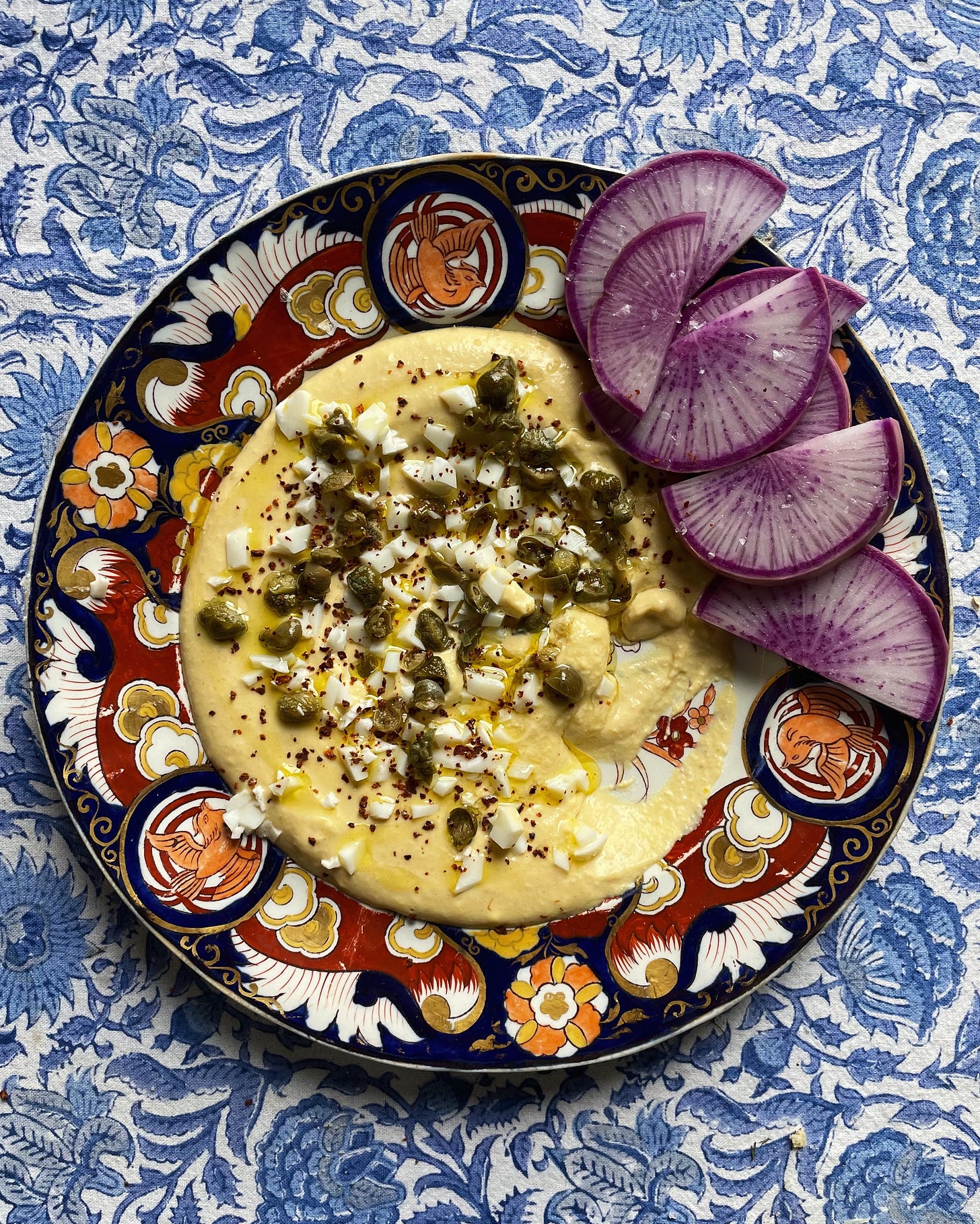This is the fourth installment of Cookbook On A Budget, in which I share cookbook recipes that aren’t unkind to your grocery bill. For more, check out Via Carota’s Onion Soup, Ruby Tandoh’s Eden Rice with Black Beans and Plantains, and Vishwesh Bhatt’s Saag-Style Collards.
I have, for the most part, figured out how to feed small groups of people in my apartment. I have a tiny galley kitchen with no counters, which means that I have minimal prep space and it’s hard to maintain a conversation between kitchen and living room. I therefore try to do everything before people arrive, but usually I fail.
For this reason, I rarely “make an appetizer”. Instead, I ask my guests to “grab some bodega snacks”. This is how we keep the spark alive in my apartment; they always bring something different, sometimes it’s delicious, sometimes it’s strange and new, sometimes it’s both. I always decant the chips into a nice little bowl. I call this move entertaining. If there are two or more kinds of chips, I call it chip salad.
There are a few exceptions to my no-appetizers rule. This spring I made the deviled eggs with pickled mussels from Anna Hezel’s Tin to Table, which has you blend the pickled mussel liquid into the yolk-y filling. They were an excellent conversation piece: I think Lindsey said something like these are for people who REALLY like mussels but also we ate them all, eagerly. I’d eaten them at Anna’s book party and wanted to put my new mussels in escabeche to good use. But it was an uncharacteristically laborious choice for me, in that it required piping the filling into the eggs with a ziploc bag. I am not a pastry girl; I do not pipe.
I’ve also, in the past, enjoyed a dip, and even enjoyed making them. For a long time, Alex Testere’s Sautéed Yogurt and Onion Dip was my go-to, to the extent that certain friends would ask for it. And then I fell in love with Ben Mims’ charred scallion dip, because Brette was always making it, and it was so delicious. But these recipes—which I love!—require chopping and cooking and mixing, all for something that won’t even be eaten at the dinner table. In my small kitchen with no dishwasher this is a hard sell.
When Amy Thielen’s new book, Company, arrived with a heavy thwack on my dinner table, one of the first dishes that popped out to me was her deviled egg dip. Because first of all it’s such a smart idea: haven’t we all wished we could eat the filling of a deviled egg, maybe with a spoon, without worrying about the whites? And second of all, well, you really just have to boil some eggs and turn on your food processor to make it.
The book, which is divided by menus, takes seriously the logistical and laborious lift a party requires. But it is less a didactic effort than a celebration of Thielen’s habit of throwing parties. She and her family live in a remote part of Minnesota, which means seeing friends often means having people over.
The book celebrates the good-enough dinner party, where pleasure is valued over perfection. But it also offers, through its photos of Thielen’s property and kitchen and food, a bit of escapist aspiration. Reading it feels like the home cook’s version of a young cook reading the noma cookbook. If I uprooted my life and went somewhere beautiful and acquired so many skills, my work could create this too. Perhaps this says more about me than the author. Thielen’s intent is not aspiration; I don’t think she’s aiming to become some midwestern Martha Stewart. She’s just incredibly good at feeding people, and this is what it looks like.
So many modern cookbooks are dinner party books without admitting it. If I’m going to make a lamb shoulder, I’m having people over. If I’m making an elaborate sandwich, I want at least two other people eating it with me. If I’m cooking for one or even two, I’m more likely to fire up the NYT Cooking app than scan my shelves. Company accepts this reality and builds a delicious plan on top of it.
I’ll disclose I first ate the egg dip at the Company book party. I’d dog-eared it in my copy already, and texted a picture of it to Brette, my date for the night, saying I hope they make this tonight and I think they will. Well baby I was right!!!! And here I have made it again. This dip is an aggressively easy sell, especially since people love deviled eggs but everyone knows how annoying they are to make. I’ve already piped something out of a ziploc once this year, and I won’t do it again for at least another twelve months.
I had first wanted to write about Thielen’s matafans in this column, a French potato-cabbage-leek pancake thing. At some point this winter I will be serving it next to a roast chicken and my friends will ooh and aah at its face, which Thielen describes as acorn brown, and then they will take a bite and think oh, butter! It’s a simple thing turned elegant from whipped egg whites, but I felt a little bad asking you to whip egg whites for a side dish. Perhaps because to do so, I have to stand on a very small antique stool to get my stand mixer off a shelf and every time I do I worry it will kill me. So instead, we’re blending our eggs in a food processor. This recipe is a whole lot easier, and this column is allegedly about approachability. And again, I’ll reiterate—it’s deviled egg dip.
The last thing I’ll say is that this book is written so beautifully. Thielen is equal parts cook and writer, the sort of person whose word choice in a recipe get me really revved up1. (To make the matafans, for example, you will cook the leeks and cabbage at a driving pace.) In the book’s introduction, she writes, I wrote these recipes, menus, and tangential thoughts for a circle of exactly three: you, me, and our cooking practice. The book sings because of this recognition, that cooking is a practice unique to each person, and sometimes all a cookbook author can do is offer up some words and say here, maybe this? Or here is how I do it. I will never grind my own meat for burgers and I am unlikely to make venison bordelaise but I can still dream of the version of myself who might be able to host twenty people without going insane. The egg dip is a good first step.
Amy Thielen’s Deviled Egg Dip
Serves 6 to 8; halves easily
8 large eggs
1 teaspoon white vinegar (rice, wine, or distilled)
5 tablespoons mayonnaise
2 tablespoons fresh lemon juice
1 tablespoon Dijon mustard
1 tablespoon Worcestershire sauce
1/2 teaspoon fine sea salt
1 tablespoon capers
Aleppo pepper or paprika for garnish
Extra-virgin olive oil for garnish
MB Note: Thielen begins by poaching her eggs, but you can just as easily hard boil them. I’ve learned that chalkier yolks make for a thicker dip, while wetter yolks make for a wetter dip. Either way, it’ll be delicious. As for what to do with your leftover whites: sprinkle them with flaky salt and more aleppo pepper and pretend you’re snacking in the ‘90s. If you have leftover dip, it would be brilliant on a (turkey? chicken?) sandwich.
Partly fill a deep wide-bottomed saucepan with cold water and bring to a boil. Add the vinegar and a pinch of salt and, one by one, crack the eggs into the simmering water. Gently troll the bottom of the pan with a spoon to make sure the eggs don’t stick, and cook just until the yolks feel hard to the touch, 5 to 6 minutes. Remove the eggs with a slotted spoon and drain them on a paper towel-lined plate.
Drop 2 whole poached eggs into the bowl of a food processor. Pop out the rest of the yolks and add them to the processor as well. Finely chop 2 of the egg whites for garnish; reserve the rest for another use. (I’m sorry I couldn’t incorporate the extra whites into the recipe; I hope you’ll find a use for them.)
Process the whole eggs and yolks to a fine fluff. Add the mayonnaise and process again until smooth, stopping once to scrape down the sides of the bowl. Add the lemon juice, mustard, Worcestershire, salt, and pepper and pulse to combine. Don’t overman, or the mixture will become tough—you want it to be soft and luscious.
Spoon the deviled egg dip onto a platter. Chop the capers, and sprinkle across the top. Scatter the reserved chopped egg whites over the dip and garnish with a few strong shakes of Aleppo pepper or paprika and a thin swirl of extra-virgin olive oil.
Serve with crackers or thinly sliced radishes, carrots, and kohlrabi.
Budgetary breakdown: based on a dozen eggs that cost $8, this (filling!!) dip will cost you around $14 for 6-8 servings, including crackers and dipping vegetables. Skip the crackers and it’s even cheaper, plus you can make jokes about “going keto”.
I read her memoir, Give A Girl A Knife, this year and highly recommend it.







Oh yummmmm -- definitely sounds messy lol but I also want to eat it
Looks delicious! I recently had a deviled egg sandwich at a cafe - it was literally smashed deviled eggs on toasted bread with extra mayo, lettuce & tomato. Divine and messy. This dip looks like a much better version!